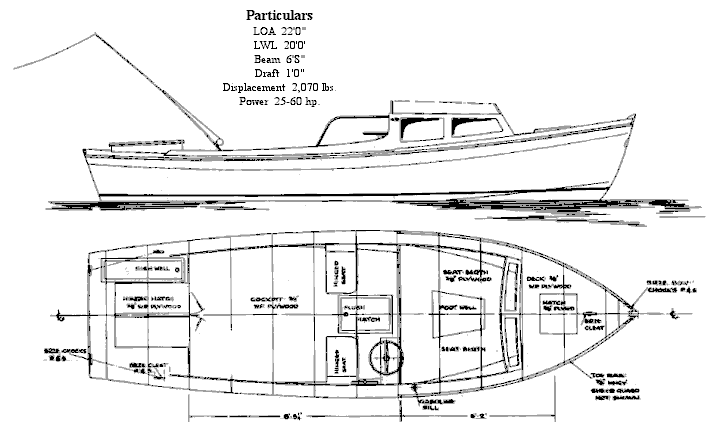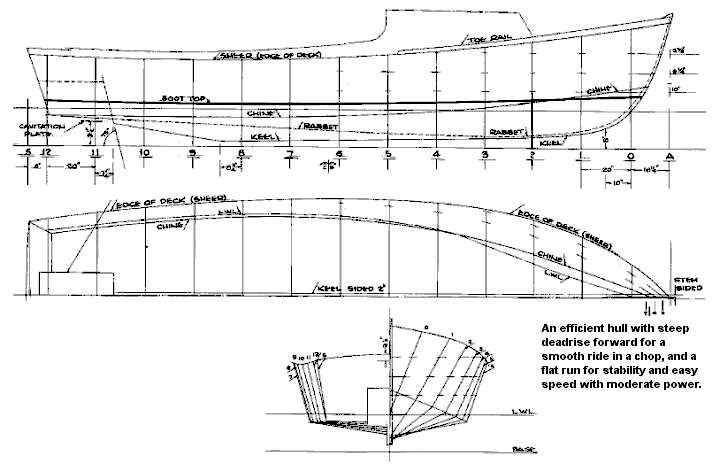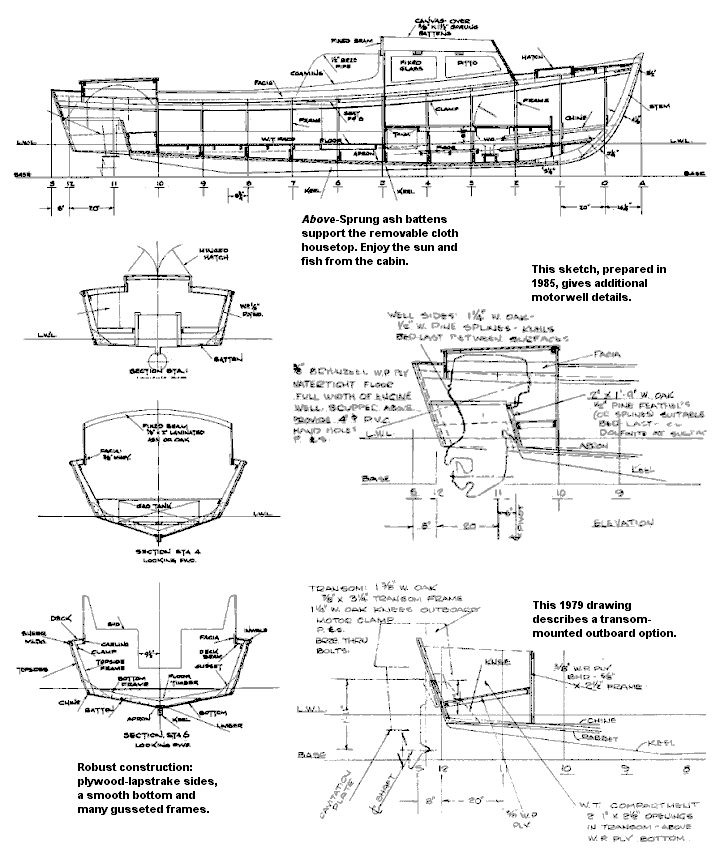

![]()

This 22' skiff seems about perfect for most of our needs: She's easily driven by a modest outboard motor (25-60 hp) and runs flat, smooth, and dry. We'll spend most of our time in the huge cockpit...not in the cabin. But when we do go "below," we'll find a head and sleeping room for a couple. If we fall victim to claustrophobia, we'll simply roll back the cloth housetop and stow its ash battens. The large fixed windows will block the breeze, and we can hunker down on the berths and look up at the sky. What a fine place to enjoy the last warm sunlight of late September.
John Atkin designed Ninigret for Dudley Slocum in 1963. The client wanted a practical fishing boat for use in Florida and at his summer home on Ninigret Pond in Rhode Island. I'll suggest that you visit this pond (really a coastal lagoon) on a clear day in September, after the last tourists have retreated to New York. Idle through miles of salt marsh. Then head out through the Charlestown Breachway (inlet) to Block Island Sound. If the surf is mild, put ashore on the virgin barrier beach. Walk along the water's edge for a mile or so, and find the hidden paths of sugar sand that meander through the dunes. Life doesn't get any better.

Let's take a look at this skiff's hull lines. Healthy deadrise at the forward bottom warps down to about 15' amidships and disappears at the transom, which shows us a dead-flat lower edge. Atkin tells us to sheathe the bottom with high-quality 3/8" plywood. We should understand that, when we wrap these sheets around the forefoot, they will bulge slightly outward. The frames in this area should be adjusted to fit. The cutaway heel of the stem will make an easier job of sheathing the forefoot, and it might result in more predictable performance when Ninigret runs off in a steep chop. She'll be less likely to root and broach.
We'll plank the sides clinker fashion with four strakes sawn from the same 3/8" plywood sheets. Ninigret's sides run fairly straight and show little change in shape. This is simple work, but let's take care with lining off.
Before we leave the lines plans, note that Atkin specifies the precise height of the motor's cavitation plate (9 1/2" above the baseline). This would seem preferable to simply indicating transom height, as motors vary slightly in the crucial clamp-to-plate dimension. While we're at it, I'll suggest that you never, absolutely never, build a motorwell for an outboard before you have purchased the engine. The well should be sized to the particular motor. If you build to the plans as drawn, there is a good chance that the engine will not fit into the well...or, if it does, it won't have room to turn or tilt. On occasion, this has happened even to professional builders. If you don't mind, I'd rather not talk about it.
The bottom edge of Ninigret's keel slopes up at its after end. This will allow the boat to turn more easily, but I expect that Atkin drew the angle to ensure that the propeller would be working in less disturbed water. As a young fellow, I was taught that we should cut off the trailing edge of an outboard boat's skeg at an angle of 15' to the perpendicular. Out on the water, this often proved insufficient. If your outboard motor is mounted at the correct height (check the cavitation plate) and yet the propeller seems to "suck air" when given only the slightest provocation, try cutting the skeg's after edge to a greater angle. You might consider entirely removing the aftermost few inches of the skeg. Work in gentle increments, and please be aware that this publication is not a profitable target for litigation.

Through the years, John Atkin added drawings to Ninigret's plans. In 1979, at the request of Dr. T. E. Becker, he drew a transom-mounted outboard option. Drawings dated 1985 give greater detail for the fuel tank, furniture, controls, and motorwell.
How powerful an engine should we fit to Ninigret? Early on, the designer suggested 25-30 hp. A note on the original 1963 drawings warns: "No more than 40 horsepower." Experience seems to have shown that the skiff could be happy with more horses. A 1985 motorwell detail drawing allows up to 60 hp.
In the mid-1980s John Atkin, working with a friend, built a Ninigret for his own use. For several years he and his wife, Pat, cruised and picnicked their way around the western end of Long Island Sound. Pat holds fond memories of the pleasant episodes.
Tony Bries, doing business as Freedom Boatworks, built several of these skiffs in Wisconsin during the 1990s. His preferred engine seems to have been a 25-hp four-stroke outboard, which reportedly drove the production boats to speeds of 18 mph.
Ninigret appears to be one of those simple, unassuming, well-mannered boats that everyone likes. In Practical Small Boat Designs (International Marine, 1983) the designer quotes an Ohio builder who talks of often receiving compliments from 'people who know boats.' As for the original skiff, Atkin wrote: "Dudley Slocum has now owned the Ninigret for twenty years, and from time to time, he calls...to tell me what a fine boat she is. I must reciprocate by saying that he has been a fine friend over these many years."
![]()
Plans for Ninigret are $100